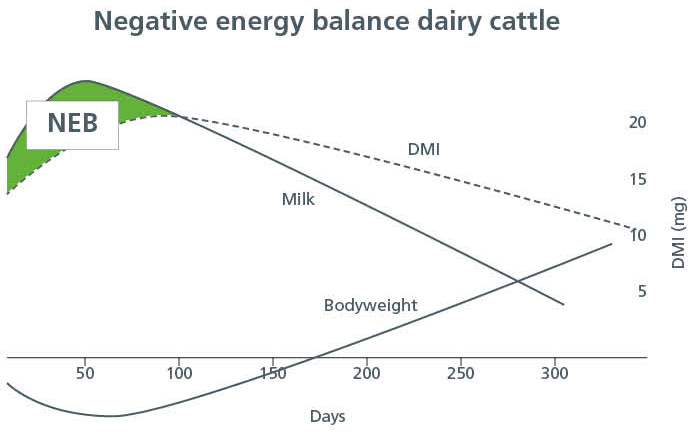Next day delivery
Order before 2:00PM
Free shipping
For orders above €100,-
Safe pay
By iDeal & Klarna
This is a common disease in dairy cattle: ketosis, also known as chronic milk fever. Studies show that in the first two months after calving, some one in ten cows suffers from this (Veeteelt 2 feb. 2012). The percentage of cows that suffers sub-clinical ketosis is even higher. The costs of ketosis are estimated at € 250 and € 600 per cow per lactation. Good reason then to do everything you can to reduce chronic milk fever on your farm.
Ketosis is the result of a negative energy balance. This occurs as the cow begins to produce large volumes of milk after calving. However, feed uptake lags, so the cow does not get enough energy. This is also clearly shown in Figure 4 below. The blue line is milk production, the black broken line is dry feed intake and the green dotted line is bodyweight. It’s clear to see that at the beginning of lactation, milk production is higher than the dry feed uptake, causing the cow’s bodyweight to decline.

Figure 4. Schematic illustration of negative energy balance of dairy cows
Cows with ketosis are generally sluggish and have less appetite. Milk production also declines, and the cow’s condition deteriorates too. The cow’s exhaled air smells of acetone, one of the ketones (Veearts.nl).
The effect of a negative energy balance is that the cow burns body fat (fat mobilisation) to meet its energy requirements. Liver function is crucial here, as this organ ensures the conversion of body fat into available energy. The liver often becomes overloaded in this situation, meaning that it functions sub-optimally and that the body fat is only partially broken down. This results in the formation of ketone bodies (β-Hydroxybutyric acid, abbreviated BHBA). When the concentration of ketone bodies exceeds a certain level (BHBA > 1.20 mmol per litre), we talk of ketosis. The result of this is that the cows are sluggish, eat less, produce less milk and are more vulnerable to diseases such as metritis and displaced abomasum. Fertility levels also decline.
With chronic milk fever, it is important that the cow is given adequate energy. This is possible using feed rations, but extra control using products like propylene glycol or glycerol is also a good option. One solution may also be sought in the dry period. If due to a good dry period the cow has sufficient uptake of dry feed at the start of lactation, milk fever will occur less often, ensuring feed uptake remains at a more consistent level. This reduces the negative energy balance so that ketosis occurs less often. If ketosis becomes a farm-wide problem, then controlling it with feed rations using propylene glycol is an effective option, but the energy level of the feed rations must also be examined critically.
